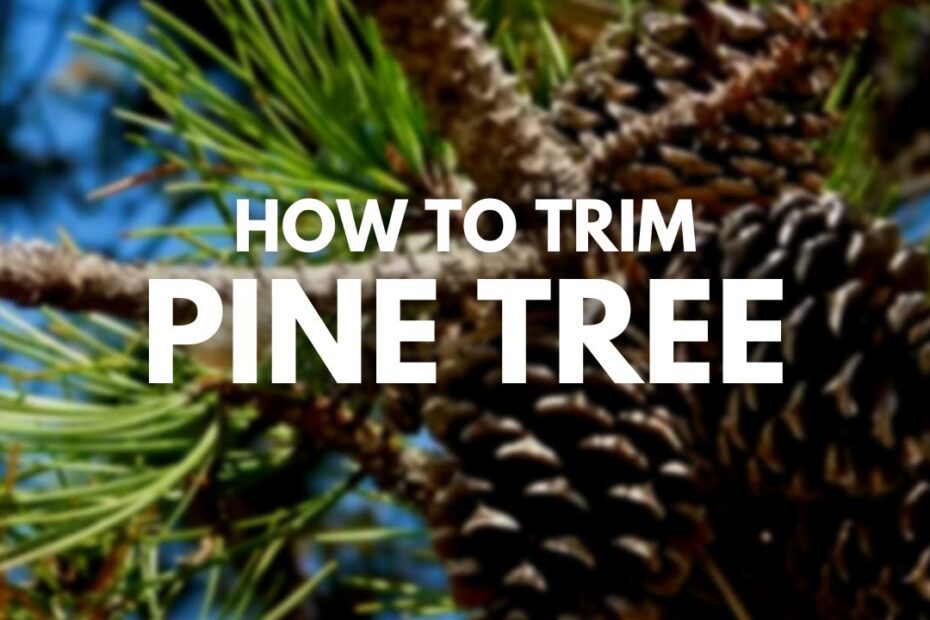Standing tall and majestic, pine trees grace our landscapes with their verdant charm. As guardians of nature’s splendor, they imbue our surroundings with a tapestry of lush greenery. Yet, behind their magnificent façade lies a delicate balance, where the art of trimming becomes an intricate dance between enhancing their natural beauty and inadvertently causing harm. So, if you find yourself faced with the formidable task of trimming a pine tree without extinguishing its life force, fear not! Embark with us on a journey through the realms of horticultural wizardry and learn how to prune these majestic sentinels with finesse and grace. Together, let us explore the secrets behind wielding blades as benevolent sculptors, enriching the world while preserving the vitality of our beloved pines. Prepare to unlock the gates to an enchanting world where harmony and lush verdure coexist harmoniously in a dance of rejuvenation.
1. Understanding the Basics: Essential Guidelines for Pruning Pine Trees
When it comes to trimming pine trees, it’s crucial to strike the right balance between maintaining their natural beauty and ensuring their health. Pruning pine trees not only helps to maintain their aesthetic appeal but also promotes healthy growth, prevents diseases, and reduces the risk of damage during harsh weather conditions. Here are some essential guidelines to help you trim a pine tree without harming it:
1. Choose the Right Time:
- Prune during late winter or early spring before new growth begins.
- Avoid pruning during hot summer months.
2. Identify Dead or Diseased Branches:
- Look for branches with wilted, discolored, or damaged foliage.
- Remove these branches to promote healthy growth and prevent the spread of diseases.
3. Mind the Leader Branch:
- The leader branch is the main vertical stem at the top of the tree.
- Never trim or cut the leader branch, as it determines the tree’s shape and height.
4. Pay Attention to Branch Collars:
- The branch collar is the swollen area where the branch connects to the trunk.
- When removing a branch, cut just outside the branch collar to promote proper healing.
| Features | Tips |
|---|---|
| Well-maintained appearance | Regular pruning keeps pine trees looking tidy and appealing. |
| Improved tree health and growth | Removing dead or diseased branches fosters healthy growth and prevents disease spread. |
| Minimized risk during storms | Pruning helps reduce the risk of branches breaking or falling during severe weather. |
Remember: If you’re uncertain about pruning techniques or if the tree requires significant trimming, it’s best to consult a professional arborist. They have the expertise to ensure your pine tree stays healthy and beautiful for years to come.

2. Pruning Techniques: Safely Trimming Pine Trees for Optimal Health and Growth
When it comes to keeping your pine trees healthy and thriving, proper pruning techniques are crucial. However, it’s essential to approach this task with caution and knowledge to avoid inadvertently harming or even killing the tree. With our expert tips, you can learn how to trim a pine tree without causing any harm, ensuring optimal health and growth.
1. Timing is Everything:
To promote healthy growth, it’s important to prune your pine trees during the dormant season. This typically occurs in late winter or early spring, before new growth begins. Avoid pruning during extreme temperatures or during drought periods, as this can stress the tree.
2. Understanding the “Three D’s”:
When identifying which branches to prune, keep the “Three D’s” in mind: dead, damaged, or diseased. These branches should be removed first, as they can negatively impact the overall health of the tree. Look for discoloration, unusual growth, or signs of decay to identify these branches.

3. Timing Matters: When and How Often to Trim Pine Trees for Best Results
Trimming pine trees is an essential task to maintain their health and aesthetics, but it’s important to approach it with caution to prevent any harm. Here, we’ll dive into the crucial aspect of timing, discussing when and how often you should trim your pine trees to achieve the best results.
The ideal time to trim pine trees is during their dormant period, which typically occurs in late fall or winter. This timing allows the tree to recover more swiftly and reduces the risk of diseases or pest infestations. It’s advisable to avoid trimming pine trees during their active growth phase in spring and early summer to avoid inhibiting their growth. As for the frequency, it’s generally recommended to trim pine trees every three to five years. However, it’s crucial to evaluate the tree’s current condition and needs before deciding on the frequency of trimming. Consulting an arborist or tree care professional can provide valuable insights specific to your pine tree’s requirements.
To ensure s
uccessful pine tree trimming without causing harm, it’s essential to consider the following features or tips:| Features/Tips | Description |
|---|---|
| 1. Pruning Tools | Utilize clean and sharp pruning tools, such as bypass pruners or pruning shears, to make precise cuts and minimize damage to the tree. |
| 2. Branch Selection | Identify dead, diseased, or damaged branches to remove, as well as any crossing or rubbing branches that may impede the tree’s growth. |
| 3. Proper Technique | Adopt the correct pruning technique by making cuts just above the branch collar, avoiding leaving stubs, and limiting the removal of healthy branches. |
Remember that maintaining a well-trimmed pine tree not only enhances its beauty but also contributes to its overall health and lifespan. By considering the timing and following proper techniques, you can achieve the desired results without jeopardizing the well-being of your pine tree.
4. Tools of the Trade: Essential Equipment and Proper Safety Measures for Pruning Pine Trees
<p>When it comes to trimming a pine tree, there are a few key tools of the trade that every arborist or DIY enthusiast should have in their arsenal. These essential equipment items not only make the job easier, but also help ensure the tree remains healthy and vibrant. Additionally, practicing <a href="https://up-gardening.com/how-to-start-a-scag-mower/" title="How to Start a Scag Mower">proper safety measures</a> is crucial to protect yourself and prevent any harm to the tree. Here's a rundown of the essential tools and safety tips for successfully pruning a pine tree without causing any harm:</p>
<table>
<tr>
<th colspan="2">Essential Tools and Equipment</th>
</tr>
<tr>
<td>1. Sharp pruning shears</td>
<td>Ensure clean and precise cuts to minimize damage to the tree.</td>
</tr>
<tr>
<td>2. Pruning saw</td>
<td>Use for thicker branches that cannot be easily cut with shears.</td>
</tr>
<tr>
<td>3. Pole pruner</td>
<td>Allows you to reach higher branches without the need for climbing.</td>
</tr>
</table>
<p>Remember to always prioritize your safety when pruning pine trees. Here are some important safety measures to keep in mind:</p>
<ul>
<li>Wear protective goggles and gloves to shield your eyes and hands from debris and sap.</li>
<li>Ensure all your tools are properly maintained, sharp, and in good working condition.</li>
<li>Be mindful of your surroundings and avoid pruning near power lines or during inclement weather.</li>
</ul>Frequently Asked Questions
Q: Can I give my pine tree a makeover without jeopardizing its health?
A: Absolutely! With a little knowledge and a gentle touch, you can tame those unruly branches without causing harm to your cherished pine tree.
Q: How can
I ensure I’m not crossing the line between trimming and sending my pine tree to the afterlife?A: It’s all about the three-step rule! When you’re ready to trim, remember to follow these simple steps: 1) Never remove more than one-third of the tree’s total foliage. 2) Trim branches selectively, targeting dead, damaged, or crossing limbs first. 3) Always cut close to the branch collar to promote healthy healing.
Q: What’s the secret to giving my pine tree a fantastic shape while still keeping it alive and thriving?
A: Sculpt with finesse! Be mindful of the pine tree’s natural shape and follow its lead. Focus on removing the lowest branches rather than trimming the top, as it keeps the tree’s energy flowing upward. Remember, a touch of imagination and nature’s guidance will give your pine tree a breathtaking silhouette without causing any harm. As we conclude this transformative journey of pruning and shaping the majestic pine trees, let us marvel at the wonders of nature’s resilience and our ability to harmoniously coexist with it. With each delicate snip and conscientious cut, we have together learnt the art of trimming pine trees without depriving them of their life force.
Remember, dear reader, as you embark on your own arboreal adventures, patience is your most trusted companion. Like a caring guardian, it will guide you through the intricacies of maintaining the health and beauty of pine trees without causing harm.
As you wiel
d your pruning shears, envision each snip as a brushstroke upon a canvas, working towards revealing the true potential hidden within these stoic giants. Understand that pine trees possess an innate splendor, and our efforts are merely meant to enhance and refine their natural glory.In the temperate breath of spring or the chilled whispers of autumn, when the sun dances through the verdant canopy, remember to assess the specific needs of each pine tree. With gentleness and sensitivity, identify diseased or broken branches, for they bear the pain of decay and hinder growth. Trim them away, like shedding old skin, allowing the tree to breathe and embrace new life.
Let the symphony of colors that embellish the changing seasons inspire you as you sculpt the branches. Embrace the spirit of balance, striving to create a delicate equilibrium between the soaring verticality and the graceful spread of the pine tree’s foliage.
In this del
icate endeavor, never rush nor fear experimentation. True mastery is born when we explore the nuances and idiosyncrasies inherent in each tree, understanding that no two pines are alike and, therefore, no two trimming journeys shall be the same.Reflect on the interconnectedness between humans and the soaring pines, for within this dance lies a profound sense of harmony and reciprocity. As we prune these magnificent specimens, we give them the gift of renewed vitality, welcoming them into our lives as guardians of tranquility and holders of endless wonder.
May this knowledge guide you towards a world where we are not mere spectators but active participants in nurturing and preserving nature’s bountiful gifts. Remember, dear reader, as you embark on your own pruning odyssey, with a respectful touch and a mindful eye, you too can trim a pine tree without depriving it of its verdant heartbeat.
- When to Put Weed and Feed on Lawn in Michigan - October 16, 2023
- When to Fertilize Potatoes Plants - October 16, 2023
- Can You Plant Clover in the Spring - October 16, 2023
Contents
- 1 1. Understanding the Basics: Essential Guidelines for Pruning Pine Trees
- 2 2. Pruning Techniques: Safely Trimming Pine Trees for Optimal Health and Growth
- 3 3. Timing Matters: When and How Often to Trim Pine Trees for Best Results
- 4 4. Tools of the Trade: Essential Equipment and Proper Safety Measures for Pruning Pine Trees
- 5 Frequently Asked Questions


